Keying Out of Paintings – Canadian Conservation Institute (CCI) Notes 10/9
Introduction
This Note addresses the effects that keying out can have on a painting that is tacked or stapled to a stretcher. “Keying out” refers to the action of enlarging a stretcher by either tapping on wooden keys inserted into joints or by rotating expansion bolts that span joints. Keying out is frequently, but wrongly, undertaken to address slackness or deformations in a stretched painting on canvas.
After the glue size, ground and paint layers have been applied to a canvas, it is highly inadvisable to use keying out as a method to address slackness or other structural deformations to the painting. If a painting appears slack or taut (overly tight), this is the result of all of the layers acting, largely independently, in response to poor or fluctuating environmental conditions. Slackness, however, can also be related to specific structural issues, such as the breakage of brittle tacking margins. Deformations like ripples along the perimeter of the painting, bulging of the canvas or draws in the corners are a response to poor environmental conditions, which can cause uneven movement in the painting. Some of these deformations can also occur if there are insufficient tacks to secure the painting to the stretcher, if the stretcher bars shrink or if a painting is squeezed too tightly into a frame. Keying out will not correct any of these structural defects.
The effects of relative humidity and temperature on the mechanical properties of stretched paintings on canvas
Mechanical properties
Stretched paintings on canvas are made up of a number of elements: wood (stretcher bars), canvas, glue size, ground (oil ground or chalk-glue ground), paint layers and varnish. All of these components have different mechanical properties, which are not all complementary. Mechanical properties relate to the strength (also described as stiffness) or flexibility of the material and to its elastic or plastic response to stress (Mecklenburg and Tumosa 1991a). Mechanical properties are dependent on relative humidity (RH) and temperature: the higher the RH and temperature, the more flexible the material; the lower the RH and temperature, the stiffer the material. Components of the painting that are flexible at a high RH and temperature, such as glue size, ground and paint layers, will become brittle as the RH drops and will be less able to deform or elongate without breaking.
Mechanical properties of canvas
Paintings on woven canvases made of natural plant fibres such as linen, jute and cotton have a tendency to become slack on their auxiliary supports (stretchers or strainers) after stretching. This happens to newly stretched canvases and continues over their lifetime, as they age. Canvas, when first placed under tension on an auxiliary support, undergoes “crimp relaxation” or the flattening out of the waviness found largely in the warp threads as these weave above and below the weft. In fact, unless exposed to extremely high humidity (85%+), at which point there is swelling across the fibre and an increase in crimp, a fabric tends towards low tension or low stiffness.
As the canvas ages, there is a further reduction in its stiffness and strength due to dimensional changes in response to fluctuating humidity, elongation of the fibres from prolonged tensioning and weakening caused by chemical degradation. As a result, it can be assumed that old canvas paintings will be slack (below 85% RH) and that other layers in the painting (glue size, ground and paint) will dictate the tension or stress (Michalski 1991). If a painting on canvas appears slack during the summer months (or when the RH is between 85% and 65%), it is usually due to the relaxation of the glue size, ground and paint layers. As the humidity drops to between 65% and 45% RH and the brittle layers begin to contract, the canvas will tighten. If the painting continues to display slackness at humidity levels between 60% and 40% RH, then it may be that the paint and ground have cracked, with a resulting loss of tension.
Mechanical properties of size, ground and paint layers
With increasing age, and especially as the painting is exposed to episodes of low humidity or cold temperature (less than 50% RH and below 5°C), brittle or glassy materials such as glue size, ground (especially chalk-glue grounds) and the paint layers become more brittle and less capable of withstanding elongation (the amount of stretch before breaking). At a low RH, because of contraction, glue size, ground and paint layers become the stiffest components of the painting structure. Their stiffness exceeds that of the canvas, and they become self-supporting. This is why, in situations of low humidity, a painting on canvas appears taut in the short-term: the brittle layers are dictating the behaviour of the overall structure.
Overall stiffness is normally determined by the glue size, as this is the strongest of the materials and the one with the greatest contractive forces. The effect of the glue size is related to the thickness of its application, which can be significant given that this layer is meant to seal the canvas weave and to create a barrier so as to prevent the oil paint from penetrating the fibres.
Mechanical properties of auxiliary support
At a low RH, deformations to the canvas can form within a few days or weeks and appear as rippling at the corners of the painting (corner draws). These are due to the shrinkage of the wooden stretcher from loss of moisture and the development of unequal compression over the canvas with the centre of the painting under more compression than the edges. Rippling along the edges of the canvas between tacks can also occur at a low RH if tacks are too widely spaced or if some are missing.
Response of brittle layers to dynamic events
If low humidity conditions prevail over a number of months, stress relaxation and gradual elongation in the various brittle layers will reduce the overall tension and the painting will be slack on the auxiliary support. A painting may be able to ride out a long-term cycle of low humidity and to adjust to internal stresses gradually with little harm to paint layers. If, however, the painting experiences a sudden or dynamic situation while under conditions of low humidity or cold temperatures, vulnerable components which cannot respond quickly to such an event will be damaged (Mecklenburg and Tumosa 1991b). Keying out represents a sudden or dynamic intervention which will result in the failure of all brittle layers. Keying out is not recommended to correct slackness, localized rippling or bulging in a painted canvas. The next section will look at the structure and working mechanisms of different stretchers with expandable corners and explain when keying out is appropriate.
How keyed and expansion bolt stretchers work
Artists are encouraged to correct the tension of a recently stretched canvas prior to the application of the glue size and thus adjust it in anticipation of slackness due to stress relaxation, which will occur as the weave crimp flattens. There are several mechanisms for opening stretcher corners to increase tension across the canvas.
Keyed stretchers
Most commonly, traditionally built wood stretchers have corners that meet in a square or butt-end mortise-and-tenon or mitred mortise-and-tenon joint. The end of one stretcher bar is equipped with a tenon that fits into a mortise on the adjoining bar. Wooden, wedge-shaped keys are inserted into small gaps along the inner edges of the tenon. The keys should be tightly fitted without opening the joints at the mortise and tenon. A good fit ensures that the joint remains secure. Each corner usually has two keys (Figures 1 and 2), although some older stretchers were designed with only one key in each corner.
If the stretcher is large, cross bars may be present. These are secured to the outer stretcher with a tenon and full-lap mortise construction. In this instance, keys are normally placed on either side of the stretcher bar, where the tenon inserts into the mortise. Tapping the keys further into their slots using a tacking hammer spreads the stretcher bars. Figures 3a to 3d show the procedure for keying out a canvas after the initial stretching by the artist or fabricator. Keys cannot be used to close up joints once these are open; moreover, relaxing tension and correcting the mortise-and-tenon fit should not be attempted by manipulation of the stretcher corners.
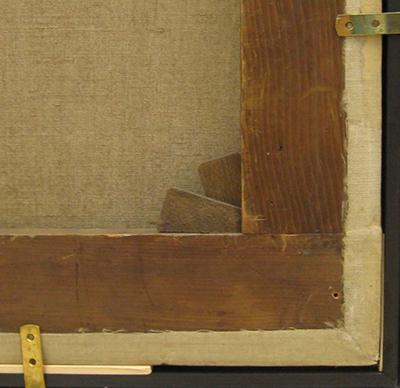
Figure 1. Wooden keys in the corner of a stretcher.
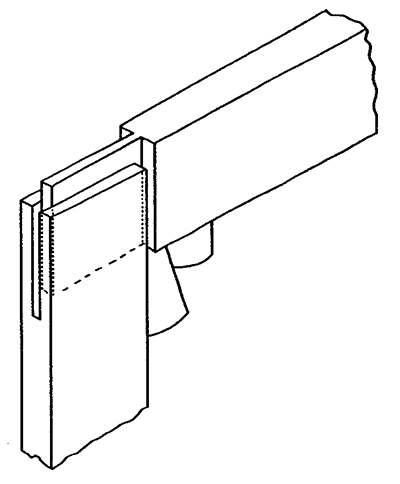
© Government of Canada, Canadian Conservation Institute. CCI 122308-0003
Figure 2. An expanded squared mortise-and-tenon joint.
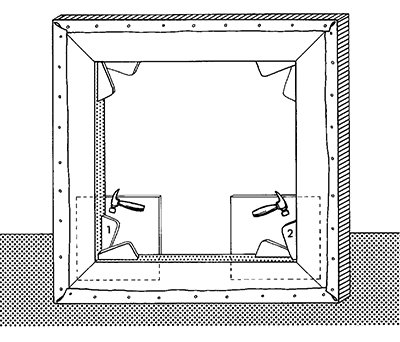
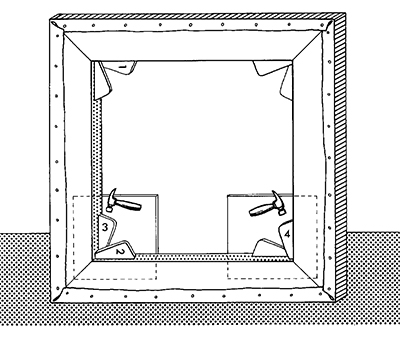

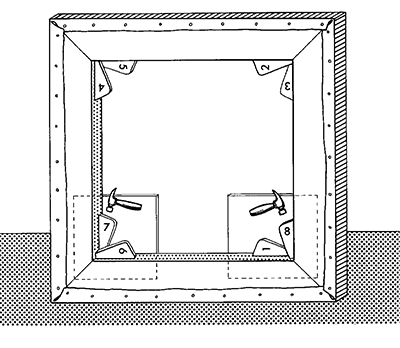
Figures 3a, 3b, 3c and 3d (top left, top right, bottom left and bottom right). An illustration of the steps in the keying out of an unpainted canvas.
Generally, especially with smaller canvases, the keying out is done in a vertical position (Figures 3a to 3d). Keys are tapped while oriented in the vertical position, as close as possible to the point of contact with the supporting surface (the lowest point of the stretcher). A single key in two adjacent corners is tapped with a small tacking hammer, according to the sequence shown by the numbering on the keys in Figures 3a to 3d. The stretcher is then rotated, allowing all keys to be tapped in turn either in a clockwise or a counter-clockwise direction. Larger paintings are easier to key out if the stretched canvas is lying flat. In this case, both keys in each corner are tapped before moving to the next corner.
Missing or loose keys
If keys are missing, the structural strength and stability of the corner will be at risk. It will be necessary to make a new key and to press it gently, yet firmly, into position (consult CCI Note 10/8 Framing a Painting). Keys should also be secured to the stretcher using the method described in CCI Note 10/8. Keys,if left unsecured, can loosen and go missing, or they can fall behind the bottom stretcher bar, causing bulging of the canvas and cracking of the paint and ground layers along the lower edge of the painting.
Expansion bolt stretchers
Turnbuckles, most commonly found in the Lebron stretcher, are designed to permit both expansion and contraction of the stretcher corners (Figure 4). A turnbuckle controlling a threaded bolt can be rotated using a metal rod, as shown. The rotation opens or closes the joint. Structural stability is provided by two unthreaded bolts set on either side of the turnbuckle mechanism (consult CCI Note 10/7 Condition Reporting – Paintings. Part II: Examination Techniques and a Checklist).
Unlike keyed stretchers where two keys must be tapped to open one corner in both horizontal and vertical axes, the turnbuckle mechanism opens the corner in both axes at once. This maintains a 90° angle at the corners of the stretcher and also results in a large gain in tension at the corner where the mechanism is used. Activating the expansion mechanism of the turnbuckle stretcher is less aggressive than tapping keys, and it is possible to close corner joints. As with the keyed stretcher, opening of the corners should only be carried out after the original stretching of the canvas has taken place and before the application of glue size, ground and paint layers.
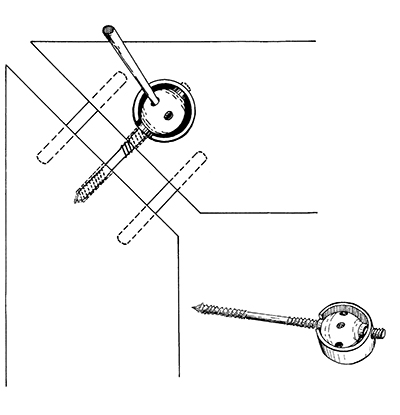
Figure 4. A turnbuckle expansion mechanism.
Potential damage from keying out a stretched painting
Paintings and the environment
It is important to reiterate that keying out is not a procedure that is recommended for a painted canvas. Keying out, especially if done at low humidity or a low temperature, will likely cause cracking of the size, ground and paint layers or, at the very least, worsening of existing cracks.
An experimental study has demonstrated that even minimal expansion of the stretcher corners, as little as 0.1 cm on a painting measuring 76 cm x 102 cm, will result in corner cracking if the humidity drops from 70% to 10% RH. This damage is very distinctive from other desiccation-related cracking and appears as diagonal lines radiating from the corners towards the centre of the painting (Mecklenburg and Tumosa 1991b). Once the paint and ground layers have cracked, the damage cannot be undone. Sadly, it may be a single action, early in the life of a painting, from an ill-advised keying out that provokes this indelible damage.
An oil painting’s susceptibility to cracking will be exacerbated over time as crosslinking of the polymer further increases the stiffness of the paint and reduces its capacity to elongate. In addition to crosslinking, damage to the paint from exposure to ultraviolet radiation or pollution and pitting of the surface from wet and solvent cleanings will ultimately reduce the paint layer’s ability to withstand strain (Michalski 1991). Once a painting has cracked, further damage will take place if additional keying out is attempted. Delamination and flaking of the paint along the edges of cracks will occur as tension is increased due to repeated keying out of the stretcher.
Unlike oil paintings, acrylic paintings are not normally prepared with a glue size, and the acrylic does not crosslink. It is not clear, however, how the long-term aging of acrylic paints will affect their ability to elongate during periods of stress. Certainly, cracking of acrylic paints does happen, and it is likely that a sudden dynamic action, such as keying out, could have serious consequences on the integrity of the paint layer. Keying out of acrylic paintings, as with oil paintings, is not recommended.
Correct tensioning and acceptable interventions
Canvases based on natural fibres are very unlikely to maintain an ideal tension, given stress relaxation and the ongoing mechanical response to humidity fluctuations. A good fabric should have “tautness under minimal applied elongation, high stiffness, resistance to both stress relaxation and creep plus isotropic Footnote 1 behaviour” (Hedley 1981, p. 2) (consult also Daly Hartin and Michalski 1987). This, in fact, is the description of an ideal lining fabric which can be used to supplement a failed original canvas.
The preservation of a stretched painting executed on a natural fabric can be promoted by ensuring that the ambient RH remains within a moderate span (40% to 60% RH) and that no sudden fluctuations in the RH occur. A slow drift downwards in RH will cause less damage than a rapid decline, by allowing a gradual stress relaxation in materials. The presence of a backing board installed on the back of the stretcher and which seals the verso of the painting can assist in protecting the painting from rapid fluctuations in humidity. The installation of a glazing layer in the frame, in conjunction with a backing board, can increase the level of protection. Consult CCI Notes 10/8 Framing a Painting and 10/10 Backing Boards for Paintings on Canvas.
A painting that exhibits slackness in the canvas, corner draws or rippling after exposure to low humidity should be allowed to equilibrate through a high RH cycle (spring/summer). If, during high RH months, the distortions do not correct themselves, then conservation interventions may be required to remove, for instance, corner draws and rippling, as these can be persistent once formed.
Any stretched painting on canvas which displays continued slackness over both low and high RH conditions should be examined for potential intervention to correct tensioning. A check should first be made to ensure that the stretcher is structurally sound (corners secure and keys all present to maintain tension of the stretcher). Next, make sure that there are sufficient points of attachment (tacks or staples) to maintain an even pull along all tacking edges. Often, tensioning problems are due to insufficient numbers of points of attachment, too much spacing between tacking points or even tears along tacking edges that compromise the stretching. If these issues are encountered, consult a conservation professional who can assess the security of stretcher corners, address tacking issues and deal with structural deterioration along canvas edges.
Tight framing or warping of the stretcher or backing board can cause an overall out-of-plane distortion of the canvas. This distortion may be reduced simply by improving the framing method.
Summary
Stretcher keys (and expansion bolt mechanisms) are appropriate for use by the artist prior to completion of the painting. However, their use long after the creation of the work of art has the potential to cause more serious problems than they set out to solve. The structural appearance of a stretched canvas painting is dictated by the mechanical properties of the component parts (fabric, wood of the stretcher, glue size, ground and paint layers), all of which are affected by ambient RH and temperature. The stiffest layer (or layers) will generally dictate the overall behaviour of the painting. This layer is rarely, if ever, the canvas, especially as the painting ages; it is almost always the glue size.
Tautness in the painting as it is exposed to low RH levels will gradually diminish as the stretcher shrinks slightly and brittle layers undergo stress relaxation over time. As the humidity begins to increase, the stretcher swells and expands and the canvas is pulled slightly tighter. Differences in compression between the centre of the canvas and the outer edges should diminish along with corner draws. However, as a painting ages, the canvas weakens and paint and ground layers lose their resiliency, which makes them susceptible to cracking. Slackness does not always resolve itself. Keying out a painting may appear to be the solution for correcting slackness or local deformations; however, cracking or worsening of cracks, loss of paint and tears along tacking edges will be the result.
If the painting cannot resolve its structural integrity through exposure to mid-range RH levels (40% to 60% RH), then advice and intervention by a professional conservator should be sought. Optimally, display or store paintings where ambient humidity is between 40% to 60% RH and temperature is between 18°C and 24°C. For added protection, or where conditions are not optimal, a backing board and glazing in the frame can buffer the painting from short-term fluctuations in the ambient environment.
Although keying out of paintings is not recommended, loose keys must be secured in order to stabilize stretcher corners and to prevent keys from falling between the stretcher bars and the canvas. Only finger pressure should be used to press in keys, and these should be further secured by methods referred to in CCI Note 10/8 Framing a Painting.
Bibliography
Daly Hartin, D. Backing Boards for Paintings on Canvas, revised. CCI Notes 10/10. Ottawa, ON: Canadian Conservation Institute, 2017.
Daly Hartin, D. Framing a Painting, revised. CCI Notes 10/8. Ottawa, ON: Canadian Conservation Institute, 2018.
Daly Hartin, D., and S. Michalski, “Methodology and Status of the Lining Project, CCI.” In K. Grimstad, ed., ICOM Committee for Conservation, 8th Triennial Meeting, Sydney, Australia, 6–11 September, 1987: Preprints, vol. 1. Los Angeles, CA: Getty Conservation Institute, 1987, pp. 145–152.
Hedley, G. “The Stiffness of Lining Fabrics: Theoretical and Practical Considerations.” In J.R.J. van Asperen de Boer, ed., ICOM Committee for Conservation, 6th Triennial Meeting, Ottawa, 21–25 September, 1981: Preprints, vol. 3. Paris, France: International Council of Museums, 1981, pp. 81/2/2-1–2-13.
Hedley, G. “Relative Humidity and the Stress/Strain Response of Canvas Paintings: Uniaxial Measurements of Naturally Aged Samples.” Studies in Conservation 33,3 (1988), pp. 133–148.
Mecklenburg, M.F., and C.S. Tumosa. “An Introduction into the Mechanical Behavior of Paintings under Rapid Loading Conditions.” In M.F. Mecklenburg, ed., Art in Transit: Studies in the Transport of Paintings. Washington, D.C.: National Gallery of Art, 1991a, pp.137–171.
Mecklenburg, M.F., and C.S. Tumosa. “Mechanical Behavior of Paintings Subjected to Changes in Temperature and Relative Humidity.” In M.F. Mecklenburg, ed., Art in Transit: Studies in the Transport of Paintings. Washington, D.C.: National Gallery of Art, 1991b, pp.173–216.
Michalski, S. “Paintings – Their Response to Temperature, Relative Humidity, Shock, and Vibration.” In M.F. Mecklenburg, ed., Art in Transit: Studies in the Transport of Paintings. Washington, D.C.: National Gallery of Art, 1991, pp. 223–248.
Young, C., and S. Jardine. “Fabrics for the Twenty-first Century: As Artist Canvas and for the Structural Reinforcement of Easel Paintings on Canvas.” Studies in Conservation 57,4 (2013), pp. 237–253.
By Debra Daly Hartin
Revised by Debra Daly Hartin in 2016 and by Wendy Baker in 2019
Originally published in 1993
© Government of Canada, Canadian Conservation Institute, 2019
Cat. No.: NM95-57/10-9-2019E-PDF
ISSN 1928-1455
ISBN 978-0-660-31542-3